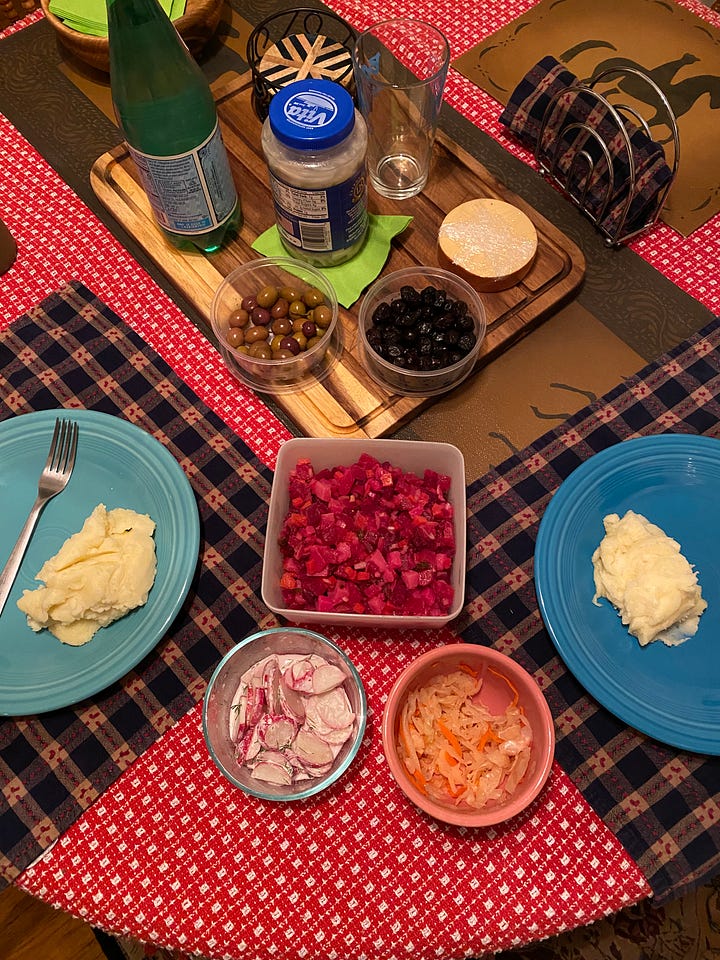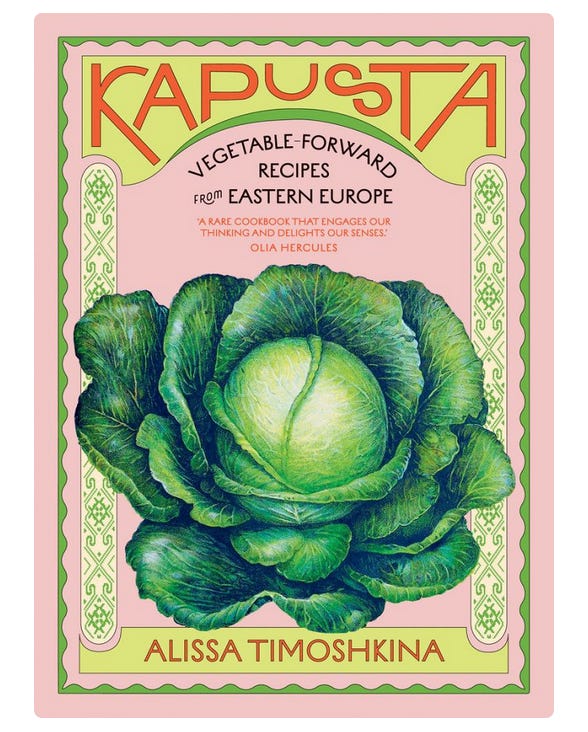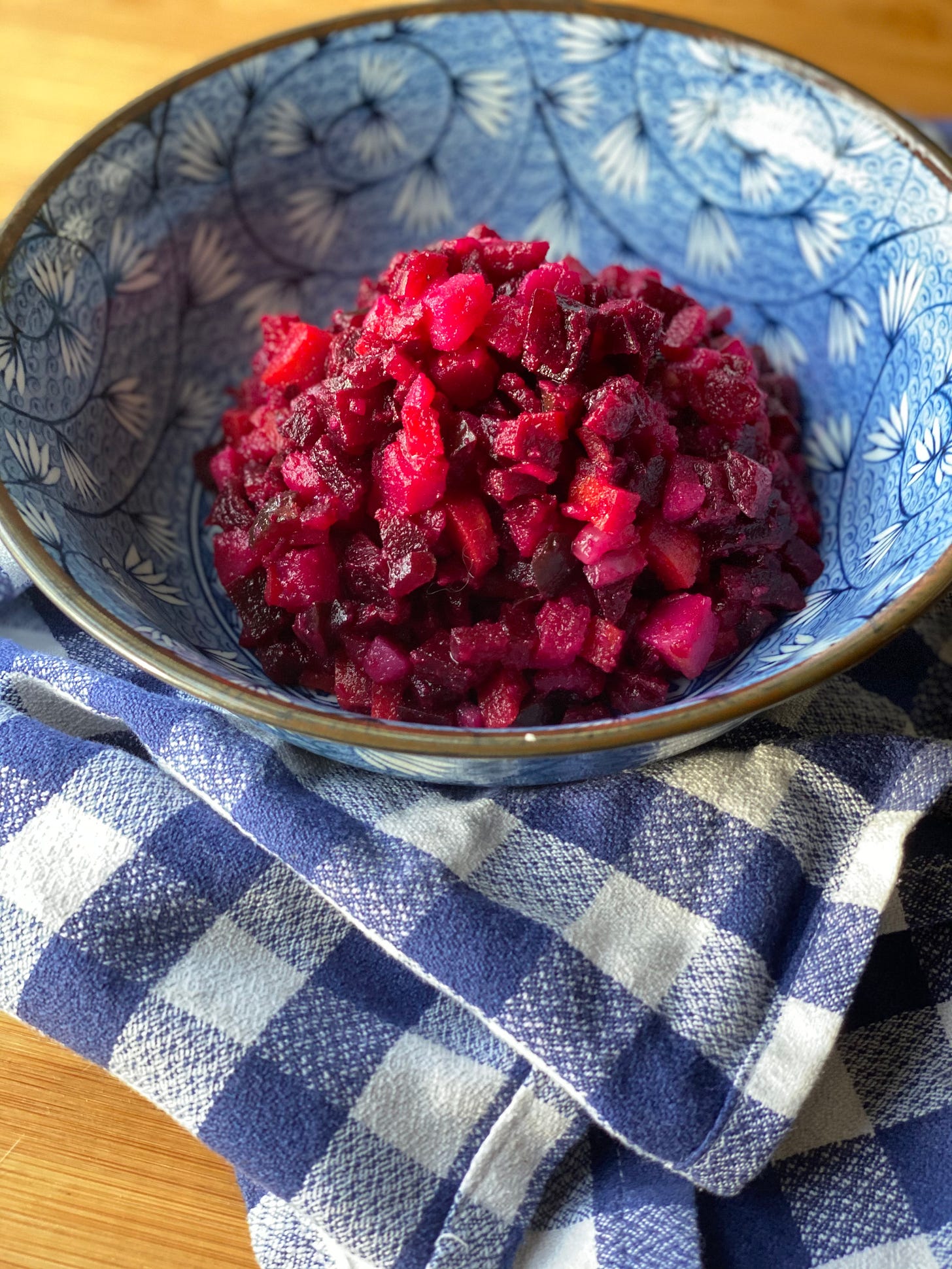Everyone's Favorite Dish: Shared, Copied, Stolen But Always Enjoyed
Vinegret: A Vegan Beet, Potato, and Pickle Salad
If you’re enjoying this newsletter, please consider becoming a paid subscriber. It’s only $30 a year. That’s like one shitty cookbook! Upon becoming a paid subscriber you will receive a copy of my digital Burnt Basque Cheesecake Cookbook Zine! Your funds will also go towards future zine publications as well as making sure that the vast majority of content is free for all.
It is not quite beet season but I can never resist beets when I see them at the store or market. Beets seem to be everywhere I look here in Ohio! In celebration of this wonderful root vegetable, I wanted to share one of my favorite beet recipes: Vinegret/Вінегре́т. Today I’m sharing my family’s version that we have been making for 80+ years, if not longer.
But before we dive in, I want to tell you a little about the dish and my hypothesis for its origin.
A brief disclaimer. As a cultural and social historian, I am of the school of thought that questions of origin are usually unhelpful, but it can be interesting and worthwhile to examine from time to time the evolution of dishes, as well as how and why they change their form over long and sometimes short periods of time.
I also believe that a dish can be created simultaneously in two different places. And I certainly encourage the cross-pollination and sharing of dishes across cultures, ethnic identities, religions, etc. We can all add our hand to these delicious dishes as we share and enjoy them. BUT none of these things are a free pass for colonizers to claim what is not theirs! Okay. Now let’s dive in.
Basically vinegret is a medley of boiled diced vegetables such as beets, potatoes, carrots, with finely diced onions, pickles and sometimes sauerkraut. Although I personally don’t like to put the sauerkraut in with the medley, my preference is to keep it on the side and mix it in with each bite.
There are many other versions that include peas, fish, meat, mushrooms that are attested in older Ukrainian, Soviet, and Russian cookbooks. My grandmother used to make a bean version as well. Vinegret is one of those flexible clean-out-your-fridge dishes you can enjoy in any season.
The dish gained mass popularity during the Soviet Union. Its humble, available and inexpensive ingredients; it's simple, but manually laborious, prep; and its shelf life ensures its success—not to mention its incredible taste!
Till this day, it is a staple dish of most ex-soviet households primarily as part of celebrations. You’ll find this dish on almost every New Year’s Eve, Christmas, Birthday, Easter table.
It is served as an appetizer or cold hors d'oeuvres, in Ukraine we call these zakuski. The more colloquial translation is actually chasers aka the thing you eat after taking a shot. And yes, it is an excellent chaser!
The Origins
The dominating narrative is that vinegret was probably introduced by French chefs sometime in the late 19th century in Russian court kitchens.
But, if we look back far enough, to me, vinegret appears to be a distant cousin of a much older Ukrainian dish called Taratuta/Таратута. Taratuta has two forms—one as a cold beet, pickle, and onion soup (particularly popular in Vinnytsia Raion of Ukraine) and the second as a beet, pickle, and onion salad.
If we compare vinegret with taratuta, it’s impossible not to see the astonishing resemblance, especially when looking at the salad version!
Taratuta is a very old Ukrainian dish from Central and Eastern parts of Ukraine. Some sources date it as far back as the 16th century when beetroot, emphasis on the root, was first introduced in Eastern Europe. Ukrainians were consuming beet greens for much longer. I’m still in the process of trying to track down historical sources to verify some of these rather messy timelines but whatever the exact date is the dish has ancient roots in Ukraine.
History is written by the victors conquerors. To be blunt: because of its proximity to Russia and the Russian Empire, this dish has been claimed by the colonizers. As has vinegret. In the case of vinegret, Russians rather believe that it’s a dish with French origins than to attribute its roots to Ukraine.
Seriously, it is straight up silly (to put it mildly) to think that they ignored, for hundreds of years, a delicious beet salad that their Slavic cousins ate every goddamn day and brought to every important celebration. In other words, it is a bit suspicious when the bully sat next to you in class has the same answers on their test.
There are also plenty of Finnish, Scandinavian, and German beet salads that could have inspired the creation of vinegret. Many of which use an acid and add salted fish, while the French use mayo. Seemingly the closest recipe to vinegret is taratuta.
Was there also French influence on the dish as we know it today? Yes, the probability is very likely. The French culinary term macedoine means cutting fruits or vegetables into small cubes. This French culinary technique gained popularity in restaurants and noble families across the 19th century Russian Empire. It is well known that the Russian Empire went through a pretty serious Francophile stage, I mean just try reading War and Peace. Did this French technique influence the form of vinegret that’s known to us today? Yes. Were the vegetables cut macedoine in the oldest versions of taratuta? Probably not. Personally, I prefer to cube my veg. However…IS THAT A REASON TO ERASE UKRAINE FROM THE NARRATIVE OF THIS DISH? ABSOLUTELY FUCKING NOT.
These are just some of my initial thoughts on the topic, I will report back as things keep developing in my research.
If you want to explore the taste of taratuta, since you have been reading about it, you can find my recipe for the beet, pickle, and horseradish salad in a previous newsletter.
Additionally, you can find the recipe in my friend’s Alissa Timoshkina’s upcoming second cookbook, Kapusta. The cookbook is a celebration of vegetables across Eastern European and its many culinary cultures and ethnic communities. I contributed two Ukrainian recipes to the book. The cookbook comes out February 25th here in the U.S., but you can still pre-order your copy today. I am so excited for my copy. Also just look at the stunning cover!
Vinegret / Вінегре́т
Yield:
Serves 4 to 8, with leftovers
Ingredient List:
900 grams or 4 large diced boiled beets
500 grams or 3 medium diced boiled potatoes
200 grams or 3 medium diced boiled carrots
200 grams finely diced pickles
150 grams or 1 small finely diced onion
3 to 6 tablespoons pickle brine (depending on the acidity of your pickles)
5 to 7 tablespoons unrefined sunflower oil or good quality olive oil
salt to taste
To Serve:
Sauerkraut (optional)
Lox (optional)
Sourdough Country Loaf or Rye Bread
*A note on boiling the vegetables. I boil the beets separately because they take the longest. I boil the carrots and potatoes together. I peel the carrots before boiling them. Potatoes I usually don’t peel until after (some say that helps retain the flavor) other times I peel them and then boil them. Never had any issues with either method.
*Makeahead: You can boil the vegetables a day ahead of prep and let them hang out in the fridge until ready to dice and mix everything.
Method:
In a large mixing bowl, place the beets, potatoes, carrots, pickles, onion and gently mix with a spatula until all the vegetables are thoroughly combined.
Now add pickle brine, unrefined sunflower oil, and salt. Mix well with a spatula to distribute everything evenly.
It’s very important to taste the salad at this point for the right balance of salt, acid, and oil and adjust accordingly.
For example you might need to adjust the brine amount to find the right balance of acidity since every jar of pickles is different!
The salad can be served with lox, herring, sauerkraut, and many slices of sourdough or sourdough rye bread.







Really enjoyed this deep dive into vinegret. Never heard about taratuta before. Also love your idea of adding pickle brine to the salad - will have to try it next time!
I loved your beet dish...